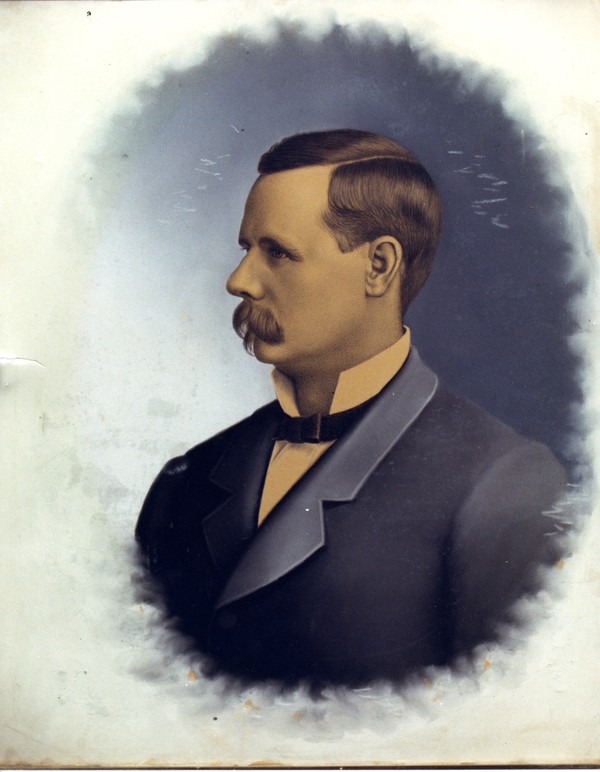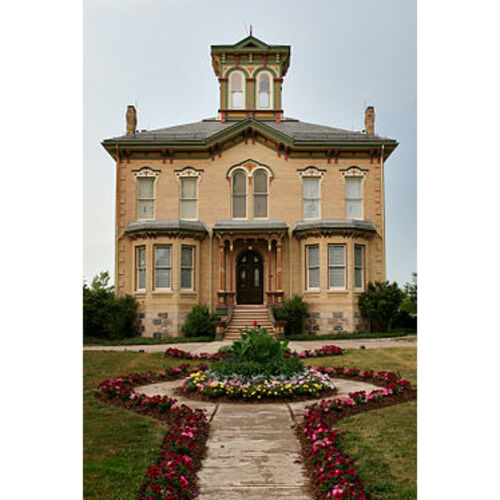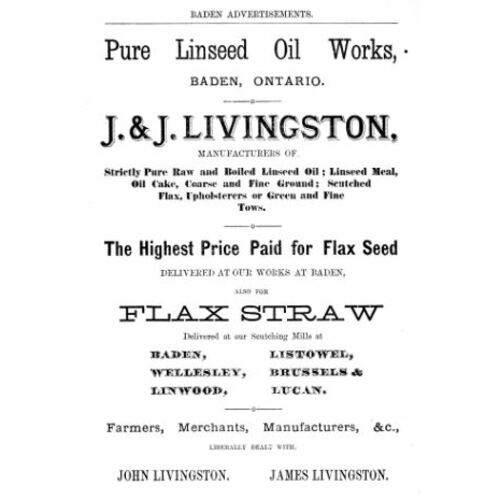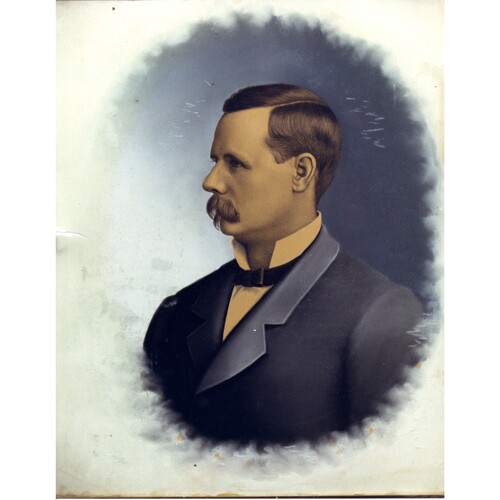
Source: Link
LIVINGSTON (Livingstone), JAMES, labourer, businessman, farmer, and politician; b. 27 Nov. 1838 (the date he and his family celebrated) or 28 Nov. (the registered date) in East Kilbride, Scotland, fifth of the 11 children of Peter Livingston and Barbara Bright; m. 10 June 1861 Louisa (Louise) Sophia Liersch (1840–1904) in Wilmot Township, Upper Canada, and they had four sons and eight daughters, of whom two sons and five daughters predeceased him; d. 15 April 1920 in Baden, Ont., and was buried there in Fairmount Cemetery.
Born into a family of linen weavers, James Livingston attended a parish school in the village of East Kilbride, just south of Glasgow, until his early teens, when he joined his father, Peter, in the weaving shop. Linen weavers in Scotland were being hit hard by mechanization and competition from the cotton industry, however, and there were few prospects in East Kilbride for ambitious young men. In the mid 1850s James and his elder brother John emigrated to Upper Canada. There James spent a year as a farm labourer in Mornington Township, Perth County, and then found employment as a flax dresser with Moses Billings Perine and his brother Joseph Southworth, who owned flax mills in the villages of Baden and Conestogo in Waterloo County, which had a large German-speaking population. In 1861 James married Louisa Liersch, daughter of Baden innkeeper Charles Henry Liersch.
Livingston was made a foreman at Perine Brothers, but he saw himself becoming a flax-mill owner. Flax was the wonder product of the era: cord, twine, and fabrics were made from the stems; linseed oil, used in paints and varnishes, was produced from the leaves and stems; and the meal that remained after the extraction of the oil was sold as cattle-feed. Astutely, James recognized the need to control all aspects of the industry, and in 1864 he and John formed their own company, J. and J. Livingston, “manufacturers of pure linseed oil, oil cake & meal, green tow & flax.” They began growing flax on a small scale in Wellesley Township that year and in Baden shortly afterwards; they built mills in both locations. The American Civil War, which had disrupted the cotton industry, caused the demand for flax to rise, and the Livingstons responded by increasing the amount of land they had under cultivation and building more mills. By 1872 the company was harvesting some 3,000 acres of flax in Waterloo County and operating seven mills across Waterloo, Wellington, Perth, and Grey counties. The Livingston empire quickly grew to include the old Perine enterprise, where linseed oil was the major product, and other flax mills in Ontario as well as in Manitoba and Quebec. At its peak, the Baden mill alone employed 220 people, many of whom were local women and migrant workers who did the back-breaking seasonal work of pulling the flax by hand.
The Livingstons expanded their operations into the United States in the 1870s. The James Livingston Flax Company in Yale, Mich., was the first to begin production, and soon other mills in the state followed. James next founded the Yale Lumber and Coal Company and organized several Michigan banks. He would later purchase a controlling interest in the A. H. Hart Flax Spinning Company in New York City, which manufactured carpet yarn. Livingston also looked to diversify his business in Canada. In 1879 he took over the Baden flour mill, and shortly afterwards the iron foundry, both of which had been established by the town’s founder, Jacob Friedrich Beck, father of business giant Adam Beck*.
Flax, however, remained the most important product of the company, whose slogan, “Livingston linseed oil: the kind your grandfather used,” was a familiar sight on its ubiquitous delivery wagons. Needing more raw material to fuel the growth of his companies, James tried to persuade farmers in western Canada to grow flax instead of wheat. When they resisted, owing to the difficulty of its harvest, Livingston, according to historian Michael D. Longo, bought out western grist mills, imported flax from Argentina and India, and processed it in his newly acquired mills. With these purchases, the J. and J. Livingston Company became the largest linseed-oil producer in the British empire. After the death of his brother John in 1896, James renamed his firm the Dominion Linseed Oil Company.
In the late 1870s, by which time his fortune was assured, Livingston had turned his thoughts towards civic responsibility and community service. In 1878 he became reeve of Wilmot Township, and he successfully stood for the Legislative Assembly the following year, contesting Waterloo South as a representative of Oliver Mowat*’s Liberals. He then ran for the federal party, led by Edward Blake, in the election of 1882 and defeated Samuel Merner*, the Conservative mp for Waterloo South. The voters returned Livingston to Ottawa in 1887, 1891, and 1896. After the Liberals won the last contest, he sat as a backbencher in Wilfrid Laurier’s government until 1900, when he retired from politics. Livingston was also active in the religious sphere. Described by his son Philip Henry (Harry) as “a stout and vigorous churchman,” James founded Baden’s Livingston Presbyterian Church in 1894, partly because he had grown tired of attending the local Lutheran church, where the services were conducted in German.
Ironically, Livingston’s most important legacy does not stem from his success in business or politics but from decisions he made in the fields of architecture and the fine arts. A highly intelligent and well-read man, Livingston was never hindered culturally by his lack of formal education. He kept abreast of the latest trends and advancements in the world around him and amassed an art collection that included works by landscape painter Homer Ransford Watson*. In 1877–78 Livingston built a great house, Castle Kilbride, named after the Scottish village where he was born. Constructed in the elegant Italianate style and capped by a magnificent belvedere, the residence was the most opulent in Waterloo County and one of the largest, having 15 principal rooms and nearly 4,300 square feet of living space. Livingston hired the best tradesmen and artists to build and decorate Kilbride. Carved marble fireplaces were imported from Italy to grace the main rooms on the ground floor, and the finest furnishings were selected. Architectural historian Jacqueline Hucker notes that Livingston, whose linseed oil was profitably sold to paint manufacturers, “paid homage to the product that made him rich by embellishing his house with superbly painted mural decorations.” On the ceilings and walls of the formal downstairs rooms, itinerant artist Henry Scharstein (Schasstein) depicted scenes from classical mythology, often using the sophisticated trompe l’œil technique. The result was spectacular. Praising “their high level of execution, fine decorative quality and cohesive integration with the architecture,” Hucker states that Scharstein’s works “are outstanding examples of domestic mural decoration from the second half of the 19th century.”
James Livingston died of pneumonia and heart failure on 15 April 1920 at the age of 81. In his obituary the Kitchener Daily Telegraph praised him as “a shrewd business man” who “was held in the highest esteem by a wide circle of friends.” Castle Kilbride, designated a national historic site by Parks Canada in 1994, would still stand in the early 21st century, functioning as a municipal office and museum under the auspices of Wilmot Township.
Ancestry.com, “Ontario, Canada, marriages, 1826–1937,” James Livingston and Louisa Leroch [Liersch], 10 June 1861; “Scotland, select births and baptisms, 1564–1950,” James Livingstone: www.ancestry.ca (consulted 14 Aug. 2018). Kitchener Daily Telegraph (Kitchener, Ont.), 16 April 1920. Auction Galleries, Auction catalogue: the important collections and furnishings of “Castle Kilbride” … (London, Ont., 1988). “Castle Kilbride Museum”: www.wilmot.ca/en/Castle-Kilbride-Museum.aspx (consulted 14 Aug. 2018). [Florence Diamond et al.], More than a century in Wilmot Township (New Hamburg, Ont., 1967). “Family fortunes,” Canada Century Home (Port Hope, Ont.), no.21 (December 1986–January 1987): 36–39. Jacqueline Hucker, “Decorative mural painting of Castle Kilbride, 60 Snyder’s Road, Baden, Ontario” (agenda paper, Hist. Sites and Monuments Board of Can., n.p., 1993). Paul Knowles, Castle Kilbride: the jewel of Wilmot Township (New Hamburg, 1994). G. M. Kuhn, A history of Livingston Presbyterian Church, Baden, Ontario, Canada (n.p., [1990]). H. P. Livingston, “James Livingston,” Waterloo Hist. Soc., Annual report (Kitchener), 9 (1921): 189–91. M. D. Longo, “Castle Kilbride,” Waterloo Hist. Soc., Annual report, 73 (1985): 38–48. Marg Rowell, “Livingston house – Castle Kilbride, Baden, Ontario,” Acorn (Toronto), 19 (1994), no.3: 5–8. “St. James Lutheran Church in Baden”: stjamesinbaden.org (consulted 15 Aug. 2018). “Waterloo region generations”: generations.regionofwaterloo.ca (consulted 15 Aug. 2018).
Cite This Article
Nancy Silcox, “LIVINGSTON (Livingstone), JAMES,” in Dictionary of Canadian Biography, vol. 14, University of Toronto/Université Laval, 2003–, accessed December 31, 2025, https://www.biographi.ca/en/bio/livingston_james_14E.html.
The citation above shows the format for footnotes and endnotes according to the Chicago manual of style (16th edition). Information to be used in other citation formats:
| Permalink: | https://www.biographi.ca/en/bio/livingston_james_14E.html |
| Author of Article: | Nancy Silcox |
| Title of Article: | LIVINGSTON (Livingstone), JAMES |
| Publication Name: | Dictionary of Canadian Biography, vol. 14 |
| Publisher: | University of Toronto/Université Laval |
| Year of publication: | 2023 |
| Year of revision: | 2023 |
| Access Date: | December 31, 2025 |







